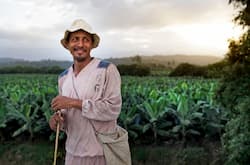Salads for Good Vision

We’re seeing green! Though aging takes a toll on eye health and vision, nutritious foods may play a defending role. A study published in JAMA Ophthalmology provides evidence for tossing up some salad to keep your eyes healthy.
Using data from the Nurses’ Health Study and the Health Professionals Follow-up Study, Harvard researchers examined dietary information and eye health history of over 100,000 men and women aged 40 years or older. Specifically, researchers looked at daily vegetable intake and then calculated the amount of nitrate in their diets (remember, nitrates from vegetables are not the same as nitrates from meat) and monitored for primary open-angle glaucoma (POAG), the most common form of glaucoma caused by a buildup of fluid pressure in the eye, potentially leading to irreversible damage and loss of vision.
Compared with those who ate the lowest amount of plant-derived dietary nitrates, those who ate the most had 21% less risk of any form of POAG. Green leafy vegetables seemed to have the biggest effect, especially kale, mustard greens, chard, romaine lettuce, and surprisingly, iceberg lettuce.
What’s the connection? Dietary nitrates from leafy green vegetables may help regulate intraocular pressure and ocular blood flow, thereby keeping eyes healthy and glaucoma at bay. Previous studies have linked eating green vegetables with lower risk of glaucoma and cataracts. In addition to nitrates, leafy greens contain lutein, zeaxanthin and beta-carotene, all plant compounds that support overall eye health.
Salads aren’t the only way to add more leafy greens to your menu. Lightly sauté greens in garlic and olive oil as a side dish, or add greens to casseroles, lasagnas and soups. For another unique spin on salad, try our Salad Sipper made with DOLE® Baby Spinach.
BONUS: A Chinese study found those with the highest versus lowest vitamin C intake had 19% lower risk of cataracts. Pineapple, strawberries, kiwifruit, guava, red bell peppers, broccoli, and Brussels sprouts are all excellent sources.
Published August 1, 2016
Get Some Fresh Inspiration


